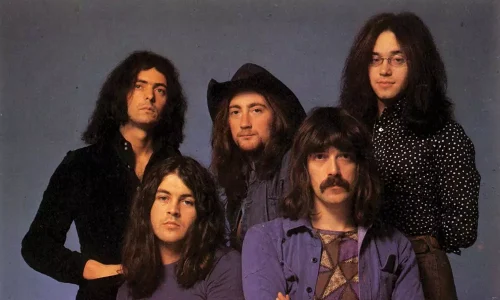Few bands have managed to leave as indelible a mark on the rock genre as Deep Purple. Emerging from the British rock scene in the late 1960s, Deep Purple has become synonymous with hard-hitting riffs, virtuosic musicianship, and a relentless drive for innovation. Often hailed as pioneers of hard rock and heavy metal, their influence extends far beyond these boundaries, making significant inroads into psychedelic rock, blues, and progressive rock.
Deep Purple’s career is a testament to their versatility and resilience. Over five decades, the band has experienced numerous lineup changes, yet each iteration brought a fresh perspective while staying true to their core sound. Their early work, characterized by a blend of psychedelic and progressive elements, evolved into the hard rock anthems of the 1970s that solidified their place in rock history. Albums like “Deep Purple in Rock” and “Machine Head” showcased their ability to craft timeless hits, with tracks like “Smoke on the Water” becoming anthems for generations of rock fans.
Early Years and Formation

Deep Purple was formed in Hertford, England, in 1968, a time when the British rock scene was flourishing with innovation and experimentation. The band’s original lineup—guitarist Ritchie Blackmore, organist Jon Lord, drummer Ian Paice, bassist Nick Simper, and vocalist Rod Evans—brought together a diverse range of musical backgrounds and influences. Blackmore’s fiery guitar work, Lord’s classical training, and the rhythm section’s tight grooves laid the foundation for what would become Deep Purple’s signature sound.
Their debut album, Shades of Deep Purple, released in 1968, showcased a band eager to explore and experiment. The album was a melting pot of styles, reflecting the members’ varied influences. Tracks like “Hush,” a Joe South cover that became their first hit, combined psychedelic overtones with a strong pop sensibility. The album also featured elements of blues and classical music, hinting at the eclectic direction the band would take in the future.
Core Elements
- Hard Rock: The driving force behind much of their music, hard rock’s powerful riffs and dynamic energy were evident even in their earliest recordings. Blackmore’s aggressive guitar style and Lord’s Hammond organ often created a heavier sound that set them apart from their contemporaries.
- Psychedelic Rock: The late 1960s was a period of great experimentation in rock music, and Deep Purple embraced the psychedelic movement. Their debut album contained extended instrumental passages and a sense of sonic exploration that was characteristic of the genre.
- Blues: The influence of blues was a constant undercurrent in Deep Purple’s music. Blackmore’s guitar solos and the band’s overall approach to rhythm and melody often drew heavily from blues traditions, adding a raw, emotive quality to their sound.
- Progressive Rock: Jon Lord’s classical training and affinity for complex compositions brought a progressive rock dimension to the band’s early work. Their willingness to incorporate lengthy instrumental sections and varied musical themes set the stage for future explorations into more intricate and ambitious territory.
As Deep Purple progressed from their formative years, these core elements would be refined and expanded, leading to the creation of some of rock’s most enduring and influential music. Their debut album was just the beginning, signaling the arrival of a band that would push the boundaries of rock and roll in new and exciting directions.
Hard Rock Foundations
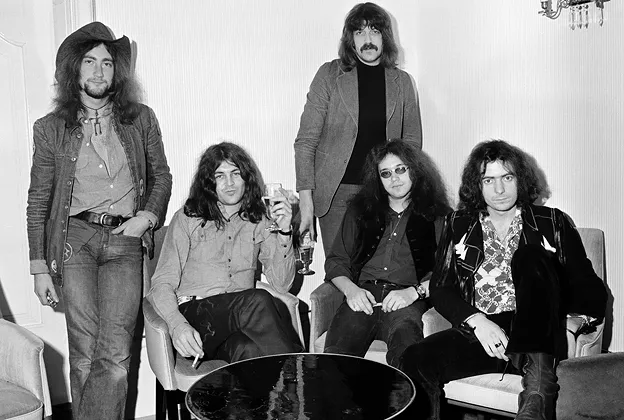
Deep Purple’s hard rock sound has been a cornerstone of their identity, defining their legacy and solidifying their place in rock history. As they evolved from their psychedelic beginnings, the band honed a powerful, riff-driven style that would become synonymous with hard rock and heavy metal.
Key Albums
One of the key albums that marked this transition was Deep Purple in Rock (1970). This album was a bold declaration of their hard rock prowess, featuring aggressive guitar riffs, thunderous drumming, and soaring vocals. Tracks like “Speed King” and “Child in Time” showcased the band’s ability to combine raw power with intricate musicianship, creating a sound that was both visceral and sophisticated. “Child in Time,” in particular, became an anthem of the era, its dynamic shifts and emotional intensity epitomizing the band’s hard rock capabilities.
The follow-up album, Fireball (1971), continued to build on this hard rock foundation. Songs like “Fireball” and “Strange Kind of Woman” demonstrated the band’s knack for catchy, hard-hitting rock tunes. However, it was Machine Head (1972) that truly cemented Deep Purple’s status as hard rock legends. This album featured some of their most iconic tracks, including “Highway Star,” “Space Truckin’,” and, of course, “Smoke on the Water.” The latter, with its instantly recognizable riff, became one of the most famous rock songs of all time, epitomizing the power and simplicity of hard rock.
“Highway Star” showcased the band’s technical prowess, with Ritchie Blackmore’s blistering guitar solos and Jon Lord’s intricate organ work driving the song forward at breakneck speed. “Space Truckin'” combined heavy riffs with a futuristic theme, highlighting the band’s ability to infuse hard rock with a sense of adventure and innovation.
Influence on Hard Rock
The influence of the hard rock genre on Deep Purple’s music is evident in their emphasis on powerful guitar riffs, dynamic song structures, and intense performances. This approach not only helped them stand out in a crowded music scene but also paved the way for future generations of rock and metal bands. Deep Purple’s blend of technical skill and raw energy influenced countless artists, from Metallica and Iron Maiden to Van Halen and Aerosmith.
Psychedelic Rock Influences

Deep Purple’s early years were heavily influenced by the psychedelic rock movement, which was at its zenith in the late 1960s. This period of musical experimentation saw bands exploring new sounds, structures, and lyrical themes, and Deep Purple was no exception. Their initial recordings reflect a deep engagement with the psychedelic genre, characterized by extended instrumental passages, eclectic arrangements, and a sense of sonic exploration.
The band’s debut album, Shades of Deep Purple (1968), is a prime example of their psychedelic rock influences. Tracks like “Hush” and “Mandrake Root” illustrate the band’s early foray into the psychedelic soundscape. “Hush,” with its hypnotic groove and swirling organ lines, became a hit and encapsulated the era’s trippy, energetic vibe. “Mandrake Root,” on the other hand, featured extended jamming and improvisation, hallmarks of the psychedelic rock genre that showcased the band’s ability to blend structured songwriting with freeform musical exploration.
Their second album, The Book of Taliesyn (1968), continued to explore psychedelic themes. Songs like “Anthem” and “Shield” exhibit a blend of intricate harmonies and ambitious musical arrangements, reflecting the influence of progressive rock as well. The track “Listen, Learn, Read On” is particularly noteworthy for its experimental approach, combining spoken word elements with complex, multi-layered instrumentation that creates a rich, psychedelic soundscape.
The album Deep Purple (1969), also known as Deep Purple III, further delved into the psychedelic territory. Tracks like “The Painter” and “April” demonstrate the band’s ability to weave complex, evocative musical narratives. “April,” an epic 12-minute piece, is a fusion of classical and psychedelic influences, with its orchestral arrangements and extended instrumental sections. This track, in particular, highlights Jon Lord’s classical training and the band’s willingness to push the boundaries of rock music.
Psychedelic 60s
Deep Purple’s engagement with psychedelic rock is contextualized by the broader movement of the late 1960s and early 1970s, which saw many bands experimenting with new sounds and breaking away from traditional rock structures. The psychedelic movement was characterized by its emphasis on extended improvisation, surreal and abstract lyrics, and the use of new recording techniques to create a sense of depth and space in the music. Deep Purple, influenced by these trends, incorporated these elements into their early work, contributing to the vibrant and diverse musical landscape of the time.
The band’s psychedelic phase was not just about adopting the popular sounds of the day but also about laying the groundwork for their future explorations. The experimental spirit of their early work paved the way for their later innovations in hard rock and progressive rock. By blending psychedelic elements with their evolving hard rock sound, Deep Purple created a unique musical identity that set them apart from their contemporaries.
Blues Roots
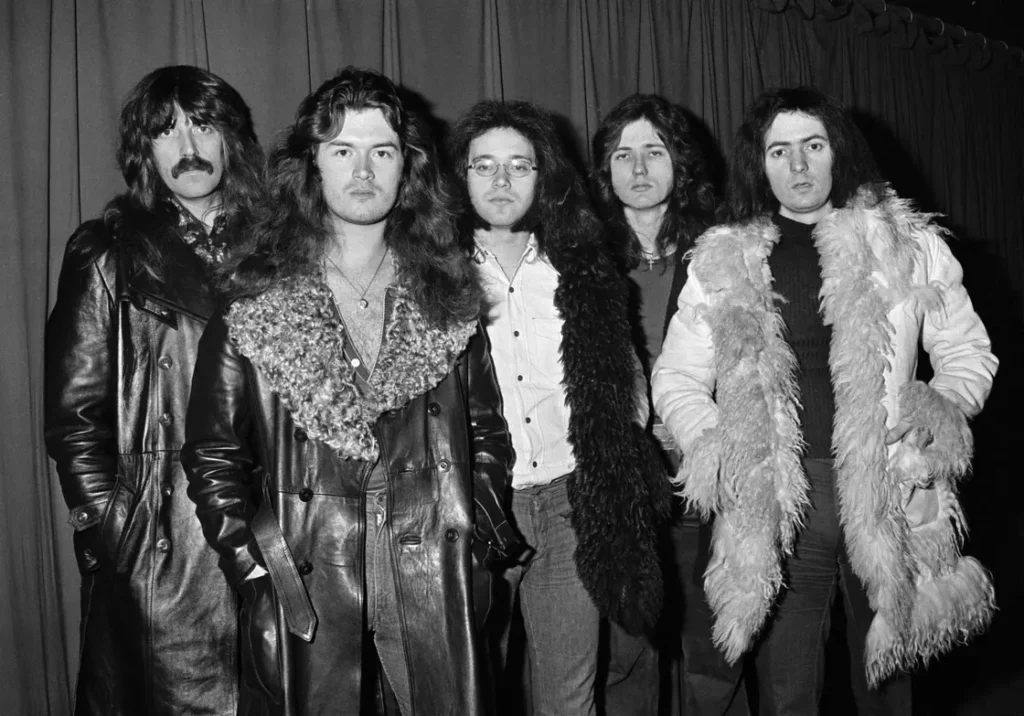
Deep Purple’s music, while often celebrated for its hard rock and progressive elements, is deeply rooted in the blues. The blues has always been a foundational influence on rock music, and Deep Purple’s work is no exception. Their incorporation of bluesy riffs, emotive lyrics, and soulful instrumentation adds a rich layer of depth to their sound.
From their earliest recordings, the blues influence is evident. Ritchie Blackmore’s guitar work often channels the raw, expressive power of the blues. His solos, characterized by bending notes and emotive phrasing, draw heavily from blues traditions. Similarly, Jon Lord’s Hammond organ often provides a bluesy backdrop, complementing Blackmore’s guitar and adding to the band’s overall sound.
Key Tracks and Albums
“Lazy” (from Machine Head, 1972): One of the most overtly blues-influenced tracks in Deep Purple’s catalog, “Lazy” begins with an extended instrumental introduction featuring Jon Lord’s bluesy organ playing. The song then shifts into a driving blues rock number with Blackmore’s scorching guitar solos and Ian Gillan’s soulful vocals. The interplay between the organ and guitar, along with the swinging rhythm, highlights the band’s blues roots.
“When a Blind Man Cries” (B-side of “Never Before”, 1972): This track is a poignant blues ballad that showcases the band’s ability to convey deep emotion through music. Ian Gillan’s heartfelt vocals and Blackmore’s plaintive guitar work make this song a standout. The slow, mournful melody and reflective lyrics capture the essence of the blues, demonstrating the band’s versatility and emotional range.
“You Fool No One” (from Burn, 1974): This track combines hard rock with a bluesy groove. The song’s riff, driven by Paice’s rhythmic drumming and Blackmore’s blues-infused guitar lines, creates a powerful, danceable track. The bluesy feel is reinforced by David Coverdale’s and Glenn Hughes’ vocal delivery, which adds a soulful layer to the song.
Bluesy Riffs and Instrumentation
Deep Purple’s approach to riffs often incorporates blues scales and techniques. Blackmore’s use of the pentatonic scale, a staple of blues music, is a defining feature of many of their songs. For instance, the main riff of “Smoke on the Water” is built around a bluesy, pentatonic structure, giving it a raw, gritty edge that has made it one of the most iconic riffs in rock history.
Jon Lord’s organ playing also contributes significantly to the band’s blues sound. His ability to switch from classical to blues styles seamlessly adds a unique dimension to the music. The Hammond organ, with its warm, rich tones, provides a perfect complement to the bluesy guitar work, creating a full, textured sound.
Lyrical Themes
Blues music is often characterized by its lyrical content, which deals with themes of struggle, heartache, and resilience. Deep Purple’s lyrics frequently touch on these themes, albeit with a rock twist. Songs like “Lazy” and “When a Blind Man Cries” delve into feelings of weariness and introspection, reflecting the blues tradition of expressing personal and emotional narratives.
Progressive Rock Experimentation
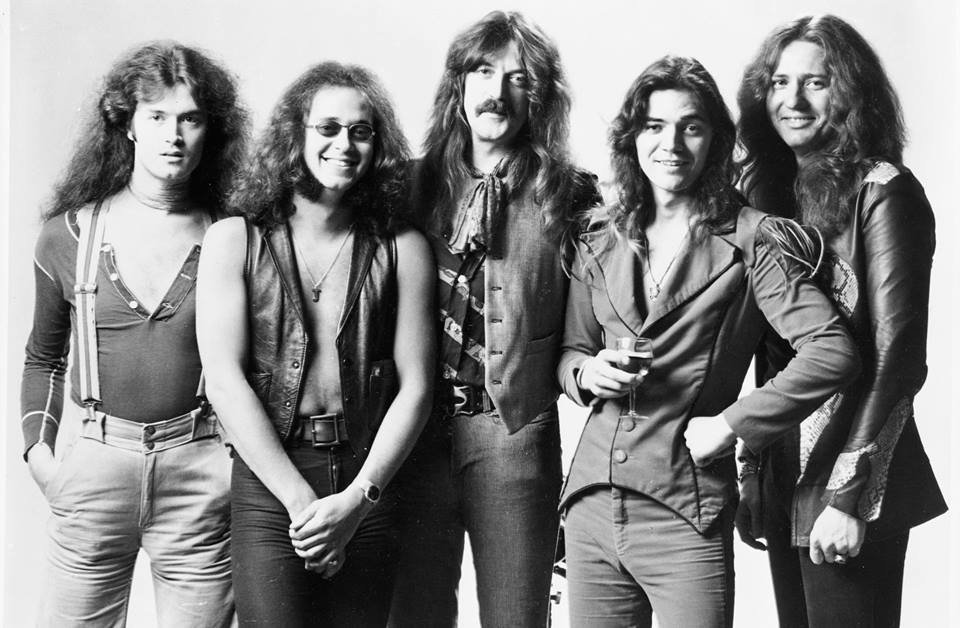
Deep Purple is often celebrated for their hard rock anthems and blues-infused riffs, but their forays into progressive rock are equally noteworthy. Progressive rock, known for its complex structures, experimental sounds, and ambitious compositions, found a significant place in Deep Purple’s musical evolution. The band’s ventures into this genre showcased their technical prowess, creativity, and willingness to push musical boundaries.
Key Albums and Songs
“Deep Purple” (1969): This self-titled third album marked a significant step towards progressive rock. The track “April,” a 12-minute epic, exemplifies their progressive tendencies. It begins with a delicate acoustic guitar and orchestral arrangement, blending into a powerful rock section with intricate solos. This composition is a clear demonstration of their ability to merge classical influences with rock, creating a complex and multifaceted piece.
“Concerto for Group and Orchestra” (1969): One of the most ambitious projects undertaken by Deep Purple was this live album, composed by Jon Lord. Performed with the Royal Philharmonic Orchestra, it was a pioneering work that fused rock with classical music. The concerto format, with its three movements and orchestral interludes, showcased the band’s versatility and Lord’s classical training. This project firmly positioned Deep Purple within the progressive rock genre and highlighted their capacity for innovation.
“In Rock” (1970): While primarily a hard rock album, In Rock features moments of progressive experimentation. The song “Child in Time” is a standout example, with its extended length, dynamic shifts, and emotive crescendos. The track’s structure, with its slow build-up and powerful climax, reflects the influence of progressive rock on the band’s approach to composition and arrangement.
“Fireball” (1971): The album Fireball continues to explore progressive rock elements. The title track features unusual time signatures and a fusion of different musical styles. “Fools” is another notable track, with its layered guitar work, tempo changes, and a middle section that ventures into experimental territory. The diversity of sounds and the complexity of the arrangements on this album demonstrate Deep Purple’s progressive rock inclinations.
Influence on Musical Evolution
The influence of progressive rock on Deep Purple’s musical evolution is significant. It allowed the band to experiment with longer, more complex compositions and incorporate a wider range of musical influences. Jon Lord’s classical background and Ritchie Blackmore’s technical guitar work were instrumental in integrating these progressive elements into their music.
Progressive rock also encouraged the band to explore thematic and conceptual ideas in their albums. The willingness to push beyond conventional rock song structures and explore new sonic landscapes helped them develop a distinctive and innovative sound. This experimentation not only set them apart from their contemporaries but also paved the way for future explorations in rock music.
Moreover, the band’s progressive rock ventures influenced their live performances. Deep Purple became known for their improvisational skills and extended live jams, which allowed them to showcase their musicianship and engage in musical dialogues on stage. These live performances often featured elaborate solos and unexpected twists, much to the delight of their audiences.
Fusion and Innovation
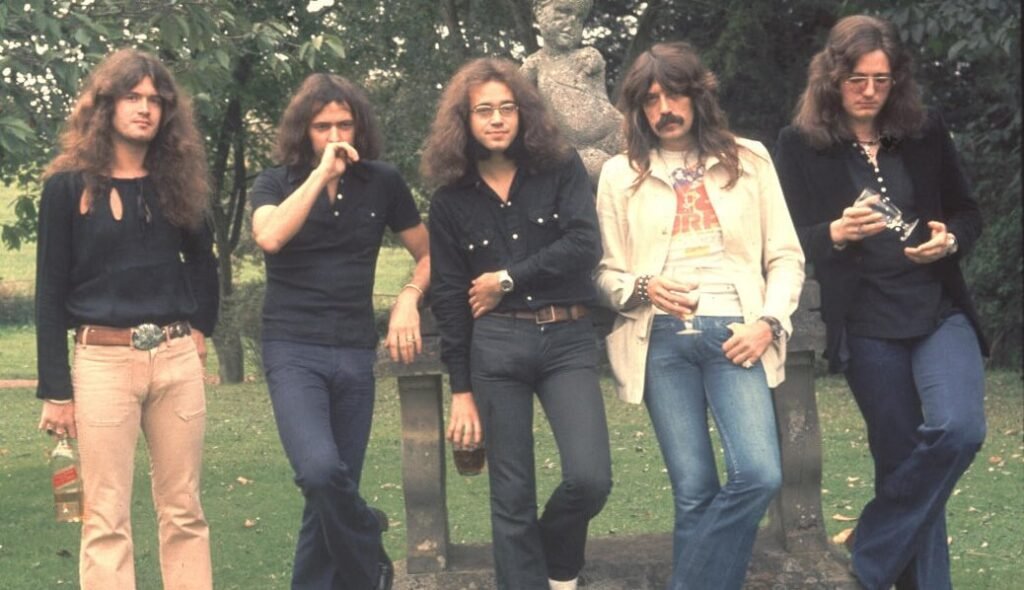
Deep Purple’s ability to seamlessly blend elements of hard rock, psychedelic rock, blues, and progressive rock is a testament to their musical versatility and innovation. This fusion of genres not only defined their unique sound but also had a profound impact on the evolution of rock music. By integrating diverse influences, they created a rich and dynamic musical tapestry that continues to resonate with audiences today.
Seamless Blending of Genres
From the outset, Deep Purple demonstrated an uncanny ability to incorporate various musical styles into their work. Their genre-blending approach was not about mixing styles for the sake of novelty, but rather about creating a cohesive sound that drew on the strengths of each genre. The band’s lineup, featuring musicians with diverse backgrounds and influences, played a crucial role in this fusion.
Key Examples of Fusion
“Child in Time” (from In Rock, 1970): This track exemplifies the seamless integration of hard rock, blues, and progressive rock. The song’s slow, bluesy beginning, featuring Ian Gillan’s haunting vocals and Jon Lord’s evocative organ, gradually builds into a hard rock crescendo with Ritchie Blackmore’s powerful guitar solos. The dynamic structure and emotional intensity reflect progressive rock’s influence, creating a multi-layered masterpiece.
“Lazy” (from Machine Head, 1972): “Lazy” is a perfect example of how Deep Purple blended blues with hard rock and progressive elements. The track starts with a bluesy organ solo by Jon Lord, followed by a series of intricate guitar and organ exchanges that highlight the band’s technical prowess. The song’s structure, with its extended instrumental sections and shifting tempos, showcases their progressive rock leanings.
“Burn” (from Burn, 1974): The title track of the Burn album is a fusion of hard rock and blues with progressive rock elements. The song features a driving hard rock riff, blues-influenced solos, and complex arrangements. David Coverdale’s and Glenn Hughes’ dual vocals add a soulful dimension, further enriching the track’s sonic palette. The intricate interplay between the instruments and the dynamic shifts within the song highlight Deep Purple’s ability to blend genres seamlessly.
Impact on Their Sound and Rock Music Innovation
Deep Purple’s fusion of genres resulted in a distinct sound that set them apart from their contemporaries. Their music was characterized by powerful riffs, virtuosic solos, and complex arrangements, creating a sonic experience that was both raw and sophisticated. This innovative approach not only defined their sound but also pushed the boundaries of what rock music could be.
The band’s genre-blending had a significant impact on the broader rock music landscape. By incorporating elements of blues, psychedelic, and progressive rock into their hard rock foundation, Deep Purple influenced the development of various subgenres, including heavy metal and progressive metal. Their willingness to experiment with different styles and push musical boundaries inspired countless musicians and bands to explore new sonic territories.
Closing Thoughts

Deep Purple’s music is a masterclass in blending hard rock, psychedelic rock, blues, and progressive rock. From their early psychedelic explorations to their hard-hitting rock anthems, and their ventures into blues and progressive compositions, they crafted a unique sound that defied simple categorization. This fusion of genres was not just a hallmark of their versatility but also a testament to their innovative spirit and technical prowess.
Their early years saw the integration of psychedelic elements, with albums like Shades of Deep Purple and The Book of Taliesyn showcasing their ability to experiment with soundscapes and extended jams. As they transitioned into a harder rock sound with albums like Deep Purple in Rock and Machine Head, the influence of blues became more pronounced, adding depth and soul to their powerful riffs and dynamic compositions. The progressive rock elements, evident in tracks like “Child in Time” and “April,” highlighted their capacity for complex structures and ambitious musical narratives.
Deep Purple’s contribution to rock music is immeasurable. They were pioneers of hard rock and heavy metal, and their innovative blending of genres paved the way for countless artists and bands. Their music not only resonated with fans across generations but also pushed the boundaries of what rock could be, influencing the development of subgenres and inspiring a legacy of musical exploration.
